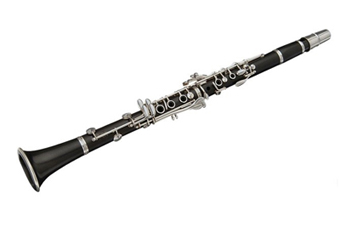The clarinet is a woodwind instrument that consists of a mouthpiece, a straight cylindrical tube with cylindrical bore (where the diameter of the holes is consistent throughout the instrument), and a flared bell. The clarinet can perform solo and with an orchestra, and is played in classical music or jazz (and even popular music).
The clarinet has five segments: the mouthpiece with the reed, the barrel (which connects the upper joint to the mouthpiece), the upper joint (where the player puts his left hand over the notes), the lower joint (where the player puts his right hand over the notes), and the flared bell. These parts can be broken off so they can be stored in a smaller case, or replaced individually if a part is damage.
The mouthpiece of the clarinet has a single reed, a thin strip of material which vibrates to produce a sound. To play the clarinet, the player stands (or sits) easy and upright (but in practice it’s easier to stand first), holds the clarinet at a 45-degree angle to the body, puts his lips to the mouthpiece, and blows.
How the mouth is positioned around the mouthpiece is crucial in playing the clarinet. If you are taking in home music lessons online or with a clarinet music teacher, it’s still important to have a good tutor who can walk you through the proper ‘embouchure.’ To do it right, your chin should be level, your throat open, your tongue high, and your mouth completely sealed around the mouthpiece. Air leaking the sides of your mouth means that the air is not going through the clarinet, and consequently, there will be no sound.
Sound is produced when you vibrate the reed. To do it, you have to blow hard with your abdomen, and you know if you are doing it properly if the air coming out is warm and moist. If it’s cold, you need to open your throat more.
It may take two to three years of weekly clarinet practice lessons for the player to learn the basic technique and develop musical abilities that will allow the player to be the third clarinet in a band.
Whether you are taking clarinet lessons at home or in a school, getting a teacher is important to have someone critique the style you have developed and weaknesses you may need to overcome it can all come together in time.
Join in today at Live Music Tutor in 3 simple steps; create your profile, select your clarinet instructor and start learning today!






